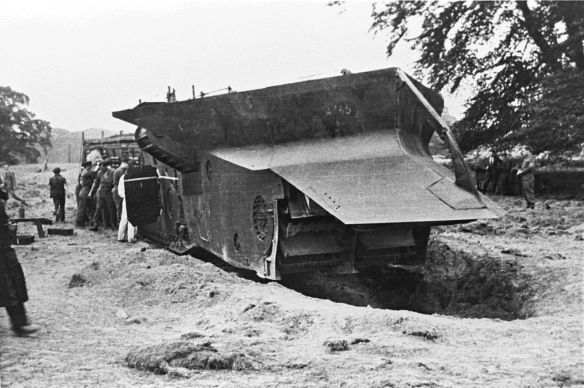A view of the Land Excavating Trenching otherwise known as White Rabbit No. 6, Cultivator No. 6 or Nellie. This machine was an underground tank developed in 1939-1940 and designed to travel across no-man’s-land in a trench of its own making. Nellie above ground front three quarters view.
Nellie above ground rear three quarters view.
Nellie was her name, this dragonlike, earth-gobbling machine that was Winston Churchill’s pet both in World War I and in World War II. Never mind that in the first of those wars she never was built, and in the second, her day already had passed. The fact is that for a time there really was a 77½ foot, 140-ton machine that slid through the earth like a giant slug and left a deep trench in her wake.
After pushing development of the tank in WWI with considerable foresight, Churchill next conceived of a fleet of mechanical “moles” like Nellie that would burrow trenches up to fixed defenses during the night. At that point, the infantry following the mechanical monster’s track would spring to the attack against a thoroughly startled enemy.
In the stalemated trench warfare of WWI, such a fleet would have been very useful indeed. But the mechanical state of the art was not yet on-line.
When World War II came along, with the long “Phony War” following the German invasion of Poland in September 1939, Churchill again proposed his mole concept, in case of another trench stalemate on the great continent lying across the English Channel.
But the German blitzkrieg unleashed against France and the Low Countries in May 1940 forever dashed the concept of static defenses withstanding the new, highly mechanized weapons of war. Nonetheless, while assuming the post of prime minister, Churchill insisted that England would have her Nellie.
Apparently for the first time, the full and detailed story of the Churchillian project, a well-kept secret during the war, appeared in a booklike “paper” published in 1988 by the Society for Lincolnshire (England) History and Archaeology as “Nellie”: The History of Churchill’s Lincoln-Built Trenching Machine, by John T. Turner.
A press release from the historical group underscored Churchill’s initial hope to avoid “the trench warfare and horrific casualties of the First World War.” Despite the highly mobile tank warfare that Nazi Germany introduced in Poland, and then employed to perfection in the conquest of France, a handful of “mole machines” was built anyway. And “Nellie was a masterpiece of heavy engineering, the biggest machine of its kind ever built, and it worked.”
As might be imagined, creation of such a huge self-propelled, trench-digging machine at a time of national emergency and carefully husbanded resources was a mind-boggling feat—“a tale of a challenge accepted, wrestled with, and overcome against terrific odds.”
Flinging away the loose dirt as it traveled, the fantastic machine “was to travel at .5 mph through no man’s land at night, cutting a trench six feet wide and six feet deep for infantry to follow and penetrate enemy lines.”
Fairly successful in field trials, the original Nellie carried a three-man crew. They were the pilot, seated in a topside conning tower with a slit window for visibility; a driver seated below, facing the rear and driving totally blind; and the unfortunate engineer, trapped in a mechanical cubicle full of oil fumes and deafening engine noise (from two 600-horsepower engines).
The machine, visited by Churchill in person during its field trials, consisted of a plow-and-cutting section in front and the “propel” section in the back. Like a very slow-moving submarine, it could dig into the earth, nose first, find its proper level, and then proceed on the chosen course (more or less). Steering, though, was a major problem, and tree roots tended to stop Nellie in her self-made tracks.
In the end, Nellie never was sent to the Continent, and she died a dinosaur’s unlamented death. Only six of the giant machines were completed.
“On Churchill’s instructions,” writes author Turner, “they were to be kept serviced and ready in case a need for them arose.” It never did, and “all but one were reduced to scrap shortly after the end of the war.” The one remaining machine, apparently the original, was consigned to like fate in the 1950s—once Churchill was out of office.
And so vanished the last of Churchill’s once farsighted mole-machines— “and much that might have been learnt has been lost forever.”
Based upon “Nellie”: The History of Churchill’s Lincoln-Built Trenching Machine by John T. Turner (Society for Lincolnshire History and Archaeology, 1988).
